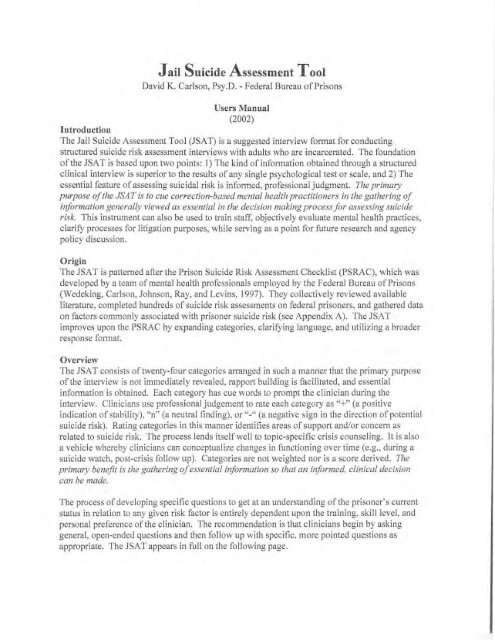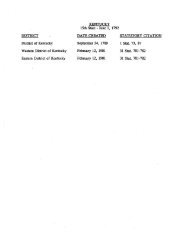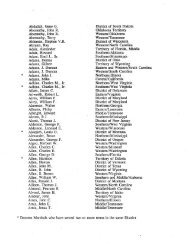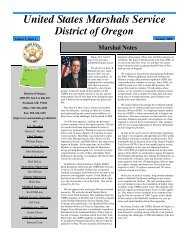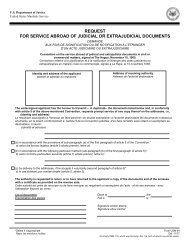Jail Suicide Assessment Tool - U.S. Marshals Service
Jail Suicide Assessment Tool - U.S. Marshals Service
Jail Suicide Assessment Tool - U.S. Marshals Service
Create successful ePaper yourself
Turn your PDF publications into a flip-book with our unique Google optimized e-Paper software.
Introduction<br />
<strong>Jail</strong> <strong>Suicide</strong> <strong>Assessment</strong> <strong>Tool</strong><br />
David K. Carlson, Psy.O. - Federal Bureau of Prisons<br />
Users Manual<br />
(2002)<br />
The <strong>Jail</strong> <strong>Suicide</strong> <strong>Assessment</strong> <strong>Tool</strong> (JSA T) is a suggested interview format for conducting<br />
structured suicide risk assessment interviews with adults who are incarcerated. The foundation<br />
of the JSA T is based upon two points: I) The kind of information obtained through a structured<br />
clinical interview is superior to the results of any single psychological test or scale, and 2) The<br />
essential feature of assessing suicidal risk is infonned, professional judgment. The primary<br />
purpose o/the JSAT is to cue correction-based menlal health practitioners in the gathering of<br />
information generally viewed as essential in the decision making process for assessing suicide<br />
risk. This instrument can also be used to train statT, objectively evaluate mental health practices,<br />
clarify processes for litigation purposes, while serving as a point for future research and agency<br />
pol icy discussion.<br />
Origin<br />
The JSA T is patterned after the Prison <strong>Suicide</strong> Risk <strong>Assessment</strong> Checkli st (PSRAC), which was<br />
developed by a team of mental health professionals employed by the Federal Bureau of Prisons<br />
(Wedeking, Carison, Johnson, Ray, and Levins, 1997). They collectively reviewed available<br />
literature, completed hundreds of suicide ri sk assessments on federal prisoners, and gathered data<br />
on factors commonly associated with prisoner suicide risk (see Appendix A). The JSAT<br />
improves upon the PSRAC by expanding categories, clarifying language, and utilizing a broader<br />
response format.<br />
Overview<br />
The JSAT consists of twenty-fou r categories arranged in such a manner that the primary purpose<br />
of the interview is not immediately revealed, rapport building is facilitated, and essential<br />
information is obtained. Each category has cue words to prompt the clinician during the<br />
interview. Clinicians use professional judgement to rate each category as "+" (a positive<br />
indication of stabil ity), "n" (a neutral finding), or "-" (a negative s ign in the direction of potential<br />
suicide risk). Rating categories in this manner identifies areas of support and/or concern as<br />
related to suicide risk. The process lends itself well to topic-specific crisis counseling. It is also<br />
a vehicle whereby clinicians can conceptualize changes in functioning over time (e.g., during a<br />
suicide watch, post-crisis follow up). Categories are not weighted nor is a score derived. The<br />
primary benefit is the gathering oj essential information so thar an informed, clinical decision<br />
can be made.<br />
The process of developing specific questions to get at an understand ing of the prisoner's current<br />
status in relation to any given risk factor is entirel y dependent upon the training, skill level, and<br />
personal preference of the clinician. The recommendation is that cl inicians begin by asking<br />
general, open-ended questions and then follow up with specifi c, more pointed questions as<br />
appropriate. The JSA T appears in full on the following page.
JSAT<br />
(JIol5 .. ulo.-.-TooI)<br />
David K. Carlson, Psy.D. - Federal Bureau of Prisons<br />
+ , A. Jmportant relationships: who, last contact, support, well-being, concerns, unresolved loss<br />
+ , B. Social status: sudden change, culture shock, predator to victim, gang issues<br />
+ , C. Legal status: pre-trial, recently sentenced, 20+ year sentence, new charges, high-risk group<br />
+ , D. Institutional adjustment: current adj ustment, history of di sciplinary actions, perceived safety<br />
+ , E. Physical health: perception ofhcailh, medical/medication concern, life-threatening condition<br />
+ , F. Physical pain: pain, intensity, duration, ability to tolerate<br />
+ , G. Chemical abuse/usc: history of substance abuse, signs of intoxication or withdrawal<br />
+ , H. Psychiatric treatment: counseling, medication, compliance, hospitalization, diagnoses<br />
+ , I. Mental status: orientation, mood, affect, thought content, agitation<br />
+ , J. Depression (current signs): severity, obvious symptoms, subtle signs<br />
+ , K.Reality testing (current signs): hallucinations, content, delusions, negative signs<br />
+ , L. Character: antisocial, narcissistic, borderline, dependent. histrionic, etc.<br />
+<br />
M. Hope: future orientation, life goals, reasons to li ve, supportive faith<br />
+ , N. Help self: perceived ability to so lve presenti ng problems<br />
+<br />
O. Cognitive themes: optimism, pessimism, exaggeration, negativism, shame, self·]oathing<br />
+ , P. Coping resources: history of coping, currcntlcvcl of di stress. level of perceived self·control<br />
• , Q. Measured reasoning: sudden destructive action toward self/others. impulsive, a "hot-head"<br />
• , R. Self-harm history: thoughts, plans, actions, circumstances, how discovered, intentions<br />
+ , S. View of death: desire to survive, ideas and attitudes about dying<br />
+ , T. View ofsuieide: study of, suicide of significant others, long history ofthoughts/anempts<br />
+ , U. Recent suicide signs: self·harm action, preparations, notes/letters, changes noted by others<br />
+ , V. Suicidal intention: resolution to act, lethal plan with available means<br />
+ , W. Cooperation: rapport, therapeutic alliance, manipulative style, convincing contract<br />
+<br />
X. False presentation: secondary gain, factitious features, rare symptoms, unusual clustering
Category Ratings<br />
The fo llowing are suggestions about ways to apply "+" and "." ratings to specific categories.<br />
These represent samples only. as it should be understood that the un ique characteristics of a<br />
given case may not always neatly fit the category explored.<br />
JSAT<br />
Page 3<br />
A. Important relationships: who, last contact, support, well-being, concerns, unresolved loss<br />
"+" Supportive relationship outside of jail with regular contact; has no worries aboul wellbeing<br />
of loved ones.<br />
"." No contacts outside of jail; emotionally significant relationship concern; painful,<br />
unresolved loss.<br />
B. Social status: sudden change, culture shock, predator to victim, gang issues<br />
"+" Perceives self as occupying an important social position; has completed education or a<br />
treatment program which is self-perceived as enhancing social position.<br />
"-" Sudden negative change in status, cultural fit, or perceived role toward others in current<br />
social milieu; current gang membership problems.<br />
C. Legal status: pre-trial, recently sentenced, 20+ year sentence, new charges, high-risk group<br />
"+" Showing clear signs of acceptance of a short/moderate prison sentence with no legal<br />
concerns; these prisoners often indicate they "know how to do time."<br />
"-" Pre-trial status; recently sentenced; 20+ year sentence; new distressing legal charges;<br />
member of known high-risk group due to legal problems (e.g., Mariel Cubans, INS<br />
detainees facing dreaded deportation).<br />
D. Institutional adjustment: current adjustment, hi story of disciplinary actions, perceived<br />
safety<br />
"+" Shows excellent adjustment to prison; has had only minor disciplinary problems in the<br />
last two years; believes prison is a reasonably safe environment.<br />
"-" Poor adjustment to prison; disciplinary problems; believes personal safety is at risk.<br />
E. Physical health: perception of health, medical/medication concern, life-threatening<br />
condition<br />
"+" Describes current health in positive terms.<br />
"-" Perceives health siruation as poorlbad; concerned about a distressing/potentially lifethreatening<br />
health problem.
F. Physical pain: pain, intensity, duration, abi lity to tolerate<br />
"+" No physical pain.<br />
"." Experiences pain that is intense and/or persistent.<br />
G. Chemical abuse/usc: history of substance abuse, signs of intoxication or withdrawal<br />
"+" No hi story of drug or alcohol problems.<br />
JSAT<br />
Page 4<br />
"." Presently intoxicated or going through symptoms of withdrawal; recent history of drug<br />
or alcohol abuse.<br />
H. Psychiatric treatment: counseling, medication, compliance, hospitalization, diagnoses<br />
"+" No present concern or history of psychiatric problems.<br />
"." Currently receiving or needing treatment for an Axis I psychiatric disorder; history of<br />
significant psychiatric concerns (e.g., hospitalization, medication).<br />
I. Mental status: orientation, mood, afTect, thought content, agitation<br />
'"+" Unremarkable mental status, positive mood, full range ofafTecl.<br />
"." Significantly impaired orientation; disturbed mood/affect; thought content or form<br />
showing signs of psychosis; severe anxiety; severe agitation.<br />
J. Depression (current signs): severity, obvious symptoms. subtle signs<br />
'"+" No signs of depression.<br />
"'." Signs of depression ranging from mild with obvious symptoms to severe with subtle<br />
signs.<br />
K. Reality testing (current signs): hallucinations, content, delusions, negative signs<br />
"+" No current signs or history of psychosis.<br />
"." Reported or suspected psychosis ranging from benign manifestations to distressing<br />
thoughts/experiences; negative signs.
L. Character: antisocial, narc issistic, borderl ine, dependent, histrionic, etc.<br />
"+" No indication of prominem character disorder traits.<br />
"." A diagnosed personality disorder; prominent, innexible. maladaptive character traits<br />
which cause significant functional impairment or distress.<br />
M. Hope: future orientation, life goals, reasons to live, supportive faith<br />
"+" Clear future orientation with life goals and/or compelling reasons to live.<br />
"." No future orientation or life goals; cannot identify reasons to live.<br />
N. Help self: perceived ability to solve presenting problems<br />
"+" Feels capable of meeting life challenges/complications.<br />
"." Feels helpless to solve presenting problems.<br />
O. Cognitive themes: optimism, pessimism, exaggeration, negativism, shame, self-loathing<br />
"+" Instant view of world and self is enhanced by rational, positive cognitive attributes.<br />
"-" Immediate view of world andlor self is dominated by cognitive themes with negative<br />
attributions.<br />
P. Coping resources: history of coping, current level of distress, level of perceived self·<br />
control .<br />
"+" Positive history for coping well during crises; convincingly presents self as fully in<br />
control of behavior and thoughts.<br />
"." History of coping dimculties; currently distressed; low level ofpcrceived self·control.<br />
JSAT<br />
Page 5<br />
Q. Measured reasoning: sudden destructive action toward self/others, impulsive. a "hot-head"<br />
"+" Convincing history of rational, thoughtful responses to life difficulties.<br />
"." Hi story of acting impulsively in a destructive manner toward self, others, or property;<br />
accepts label of self as a "hot·head."<br />
R. Self-harm history: thoughts, plans, actions, circumstances, how discovered, intentions<br />
"+" Has never thought about or engaged in an act of sclf·hann.<br />
"." Presents history of serio us suicidal thoughts, plans, or actions.
S. View of death: desire to survive, ideas and attitudes about dying<br />
JSAT<br />
Page 6<br />
Note: One means of assessing this category is to present the prisoner with a scenario<br />
involving a medical crisis which could lead to an untimely. natural death if untreated (e.g.,<br />
heart-attack), then asking follow up questions to assess desire to survive as well as ideas<br />
and attitudes about dying.<br />
"+" Convincingly expresses a desire to survive.<br />
"." Would welcome a natural death; can name good things that would occur as a result of<br />
dying.<br />
T. View of suicide: study of, suicide of significant others, long history of thoughts/attempts<br />
"+" Views suicide as undesirable and altogether negative; gives no history of significant<br />
other committing suicide.<br />
"." studies or reads aboUl suicide; has a history of significant other suicide; has a long<br />
history of suicidal thoughts or anempts.<br />
U. Recent suicide signs: self-harm action, preparations, notes/letters, changes noted by others<br />
"+" In the lasl six months has shown no outward sign of suicide ri sk.<br />
"." Recent preparation for or attempt to engage in self·harm; rccent changes notcd by<br />
others suggesting suicidal theme (e.g., giving away possessions, isolating self from others,<br />
not taking meals).<br />
V. Suicidal intention: resolution to aCl, lethal plan wilh available means<br />
"+" Convincingly denies any intent 10 harm self.<br />
"." Expresses desire to commit suicide in the ncar future; has a lethal suicide plan with<br />
available means.<br />
w. Cooperation: rapport, therapeutic alliance, manipulative style, convincing contract<br />
"+" Good rapport or therapeutic alliancc bctween prisoner and clinician; easily and<br />
willingly enters into a convincing contract to seek help in times of crisis.<br />
"." Poor rapport or therapeutic alliance between prisoner and clinician; manipulation<br />
suspected; unwilling and/or unable to enter into a convincing contract to scek help in times<br />
of crisis.
X. False presentation: secondary gain, factitious features, rare symptoms, unusual clustering<br />
Note: Individuals who are malingering or feigning symptoms of suicide or mental illness<br />
mayor may not be willing to engage in sel/'..harm gestures in order to convince staffthcy<br />
are at risk. The issue, if present, needs to be explored and conceptualized.<br />
JSAT<br />
Page 7<br />
"+" Interaction between prisoner and clinician appears to be straightforward and is without<br />
suspicion of false presentation.<br />
'"-" Suspected malingering for a known secondary gain; factitious features present; rare or<br />
bizarre symptoms; symptoms not clustered around typical diagnostic criteria.<br />
Complicated Cases<br />
Usually, the clinical judgment of the interviewing clinician is enhanced sufficiently by the JSA T<br />
process and a decision regarding suicide risk is easily arrived at. Ilowever, some cases can be<br />
quite complicated. When that occurs, two additional activities are recommended. First, seek out<br />
a qualified mental health practitioner for consultation. Most of the time that wil l clarify the<br />
issues at hand and provide a sense of professional di rection. Second, use "The Bouom Line<br />
Question" wh ich asks: If the prisoner is not placed on a formal suicide watch, and if the prisoner<br />
commits suicide, could the decision be successfully defended in a court of law? Wrestling with<br />
this legal issue often provides clinical clarity.<br />
The problem of "false positives" is a significant one, especially for the prison mental health<br />
clinician. lfevery individual presenting with a single high risk factor was placed on a suicide<br />
watch, many thousands of prisoners would be unnecessarily and continuously maintained on<br />
formal suicide watches, thus creating systemic resource burdens and violating the civil rights of<br />
many men and women. Again, ciinicaljudgemenl must be the final deciding factor.<br />
Final Comments<br />
The question is often asked, "How long will it take to complete a JSA TI" The answer is this: as<br />
long as is necessary to arrive at a sound conclusion. Simple cases with cooperative prisoners<br />
may only take 30 minutes, but tough cases may take 2 hours or more depending on the details.<br />
That may seem like bad news for the clinician who already feels overwhelmed with multiple<br />
responsibilities and limited resources. However, there arc very few professional activities that<br />
rival the critical importance of preventing suic ide.<br />
Lt is wise to be familiar with the professional literature on the topic of preventing suicide and<br />
assessing for risk. In Appendix B there is a brief bibliography for revi ew.
Appendix A<br />
Prison <strong>Suicide</strong> Risk <strong>Assessment</strong> Checklist<br />
JSAT<br />
Page 8
PRISON SUICIDE RISK ASSESSMENT CHECKLIST'<br />
JSAT<br />
Page 9<br />
[nmate Name: ______ -:-___ -;:-_:--:-: ___ Reg. No ., _________ _<br />
Dale of <strong>Assessment</strong>: _ ___ <strong>Assessment</strong> Completed by: _______________ _<br />
1. SOCIAL-RELATIONAL:<br />
r? NLS. A. Significant Other(s) Status: MarilllVother relationships; last conlnel; reccntlanlicipmcdlfcarcd cbange; infomlcd of<br />
intent 10 end relationship; unresolved crisis; nearness to significant dates; etc.<br />
B. Recent losses: Deaths; imminent loss; unusual aspects; etc.<br />
C. Status Issues: Significant alteration of circumstances; unusual high risk groups: significant loss of status; predator 10 victim;<br />
gang issues; etc.<br />
2. SITUATIONAL:<br />
£ N/S A. Criminal Justice Issues: Time in prison; lSI timer; status in reL to Court; high risk group status; government witness. etc.<br />
B.lnstitlltionallsSlles: Institutional adjustment; disciplinary issueS; trnnsfer concerns; problems with others; CIC.<br />
C. Safety Issues: Views prison environment as dangerous; identificd conflict; level offear; perception of ability to cope: CIC.<br />
3. MEDICAL:<br />
£. N/S A. Distressing Illness: Significant medical conccrtlj life thrcntcning conditions; high risk groups such as cancer, AIDS; e tc.<br />
B. Pain (Physical): Intensity and duration: ability to tolerate; strntegics for dealing with; ctc.<br />
C. Chemical AbuselUse: History of abuse/usc; current problem status such as withdrnwal. intoxication: etc.<br />
4. PSYCIDATRIC:<br />
£. N/S A. Treatment History: Type of treatment including counseling, medication, outpatient, hospitali7.ution: etc.<br />
B. Current Stalus: Diagnosis (Axis I, Axis U); medication compliance; command hallucinmions: etc.<br />
5. PSYCHOLOGICAL:<br />
f N/S A. General MenIal Health Status: Current mental Slatus; mood; acute perturbation; etc.<br />
B. Hopelessness-Helplessness: Absence of strong positive reasons to live; dependency issues; personal internal resources;<br />
unable or unwilling to continue search for solution to personal problcm; sees facton in curn:nt situation as uncontrollable and/or<br />
unchangeablc; current behaviors evidence of struggle for gaining or regaining control of life situations; etc.<br />
C. Depression: Obvious and subtle signs; severity; etc.<br />
D. Pain (Emotional): Heightened level of emotionality in relation to pain; low frustration tolerance level expressed in relation<br />
to pain: self-assessment of pain as intolerable; etc.<br />
E. Negative Cognitions (Emphasizing Self Concept): Shame, self-loathing, llndlor pereeived humiliation;<br />
pessimistic world view; exaggeration of problems; inability 10 articulate positi\'c altem ative(s); low 5Clf-esteem; eiC.<br />
F. Coping Resources: [nability to articulate cogent reasons for living; history orsenous deficits in coping; evidence for major<br />
deficits in basic living skills; presence of constriction (e.g., unable to see altcrtlatives to present difficulties and distressing personal<br />
problem); etc.
Appendix B<br />
<strong>Suicide</strong> Prevention Bibliography<br />
JSAT<br />
Page 11
Bibliography<br />
JSAT<br />
Page 12<br />
Bongar, B. (1991). The Suicidal PalienI: Clinical and Legal Standards olCare. Washington, D.C.:<br />
American Psychological Association.<br />
Fremouw, W., Pcrczel, M., & Ellis, T. (1990). <strong>Suicide</strong> Risk: <strong>Assessment</strong> and Response Guidelines. Boston,<br />
MA: Allyn and Bacon.<br />
Hayes, L. Can <strong>Jail</strong> <strong>Suicide</strong> Be Prevented? Crisis: The Journal o/Crisis Imefl'ention and <strong>Suicide</strong><br />
Prevention, 1992; 13 (2): 60-62.<br />
Hayes, L. <strong>Jail</strong> <strong>Suicide</strong>: Prevention Through Written Protocol. Crisis: The Journal o/Crisis Intervention<br />
and <strong>Suicide</strong> Prevention, 1993; 14 (2): 57-58.<br />
Hayes, L. National Standards for <strong>Jail</strong> <strong>Suicide</strong> Prevention. <strong>Jail</strong> <strong>Suicide</strong>/Mental Health Update, 1996; 6 (4):<br />
1-5.<br />
Hayes, L., & Rowan, J. (1988). National Study of <strong>Jail</strong> <strong>Suicide</strong>s: Seven Years Loler. Alexandria, VA:<br />
National Center on Institutions and Alternatives.<br />
Kaplan, 1-1., & Sadock. B., editors. (J 995). Comprehensive Textbook of Psychiatry, ed. 6, vo l. I. Baltimore.<br />
MD: Williams & Wilkins.<br />
Lester, D., & Danto, B. (1993). <strong>Suicide</strong> Behind Bars: Prediction and Prevention. I>hiladelphia, PA: The<br />
Charles Press, Publishers.<br />
Mahrer, 1.. & Bongar, B. (1993). <strong>Assessment</strong> and Management of <strong>Suicide</strong> Risk and The No-<strong>Suicide</strong><br />
Contract.lnnovalions in Clinical Practice, Vol. 12, (pp: 277-293).<br />
Rowan,1. (1991). ACA <strong>Suicide</strong> Prevention in Custody: Intensive Study Correspondence Course. Laurel,<br />
MD: American Correctional Association.<br />
Schimme l, D., Su llivan, J., & Mrad, O. <strong>Suicide</strong> Prevention: Is it Working in the Federal Prison System?<br />
Federal Prisons Journal, 1989; I (1): 20-24.<br />
Shennan, L., Morschauser, P., & Po lak, A. (1986). <strong>Suicide</strong> Prevention (md Crisis Intervention in County<br />
<strong>Jail</strong>s and Police Lock-Ups. Trainer '$ Manual. New York, NY: New York State Office of Mental Health.<br />
White, T. (1999). How to identify Suicidal People: A Sys[ematic Approach [0 Risk <strong>Assessment</strong>.<br />
Philadelphia, PA; The Charles Press, publ ishers.


